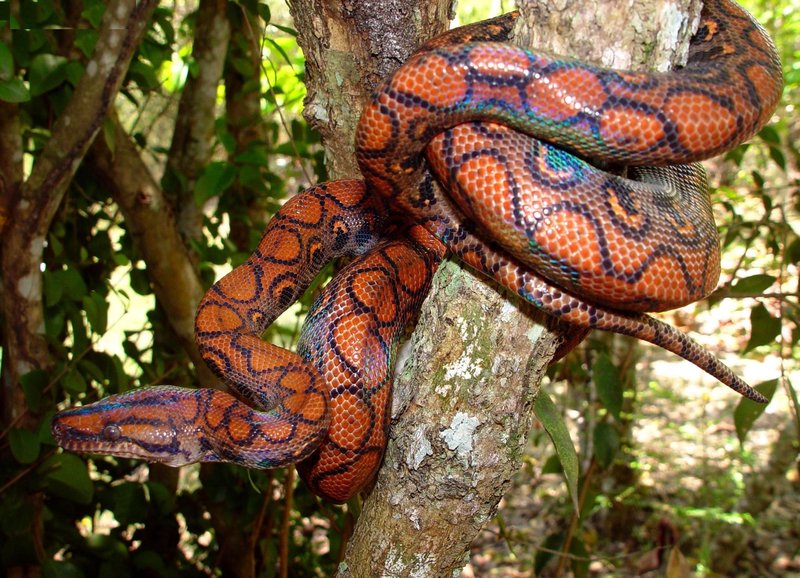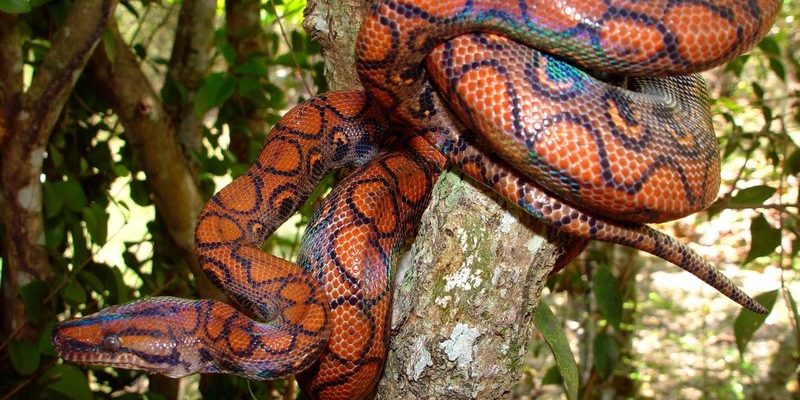
Have you ever seen a snake that looks like it just stepped out of a tropical painting? That’s the Rainbow Boa for you! Native to the lush landscapes of Central and South America, this snake is celebrated for its vibrant colors that shimmer like jewels. Often admired by both snake enthusiasts and casual observers alike, the Rainbow Boa is more than just a pretty face; it has a fascinating biology and captivating behaviors that make it an intriguing subject.
When you think of a boa, you might picture a hefty snake lurking in the underbrush. But don’t let the name fool you! The Rainbow Boa is a slender, graceful creature that relies on its stunning appearance and unique adaptations to thrive in the wild. Whether you’re a budding herpetologist or simply curious about this remarkable reptile, let’s dive into the enchanting world of the Rainbow Boa.
What is a Rainbow Boa?
The Rainbow Boa, scientifically known as Epicrates cenchria, is a non-venomous snake that belongs to the Boidae family. With its striking iridescent scales, it often mesmerizes anyone who catches a glimpse. The coloration varies among different regional populations, ranging from rich oranges and yellows to deep blues and greens. This vibrant display isn’t just for show; it plays a crucial role in camouflage, helping the Rainbow Boa blend seamlessly into its rainforest surroundings.
These snakes have a unique pattern of scales that reflects light in a way that creates that ‘rainbow’ effect—hence the name. This shimmering quality can make it tricky to spot them in the wild, as they can easily hide among the leaves and branches of their preferred habitats.
Physical Characteristics
Rainbow Boas are relatively medium-sized snakes, typically reaching lengths of about 6 to 8 feet, although some individuals can grow even longer. They possess a slender body structure that allows them to navigate through tight spaces in their forest homes. The average weight of an adult Rainbow Boa ranges from 10 to 20 pounds. Their distinctive scales are smooth and glossy, adding to their beauty and helping them glide silently through the underbrush.
The head of a Rainbow Boa is somewhat triangular, with large, expressive eyes that give them excellent vision. This is especially handy for spotting prey in dim light. Speaking of prey, these snakes are mainly nocturnal hunters, which means they do most of their hunting at night when their vibrant colors are less likely to attract unwanted attention.
Habitat and Range
Rainbow Boas thrive in tropical rainforests, near rivers, swamps, and other humid environments where they can find both shelter and food. Their range spans from the Caribbean islands of the Lesser Antilles down to the Amazon Basin, covering parts of countries like Brazil, Colombia, and Peru. These lush habitats provide not only the warmth and moisture that Rainbow Boas love but also a rich diversity of prey, including rodents, birds, and small reptiles.
Due to their preference for dense cover, Rainbow Boas are skilled climbers, often seen navigating branches and vines. They can also be found basking on tree limbs, taking in the sunlight, which aids in regulating their body temperature. The combination of their striking appearance and their natural abilities makes them a vital part of the rainforest ecosystem.
Diet and Hunting Techniques
When it comes to meals, Rainbow Boas aren’t picky eaters. In the wild, they primarily feast on small mammals—think mice and rats—as well as birds and occasionally other reptiles. They’re constrictors, meaning they wrap their bodies around their prey to subdue it before consumption. This technique requires patience and precision, as they need to wait for the perfect moment to strike.
Rainbow Boas rely on their keen sense of smell, which they detect through their forked tongues. When hunting, they flick these tongues to pick up scent particles in the air, allowing them to locate their next meal. Interestingly, they can also sense heat through specialized pits along their jaws, making it easier to find warm-blooded prey, even in low-light situations.
Breeding and Lifecycle
Rainbow Boas are ovoviviparous, which means that the females give birth to live young rather than laying eggs. After a gestation period of about 6 to 8 months, females can give birth to anywhere from 10 to 30 babies! The newborns are miniature versions of adults, measuring about 2 feet in length. They are independent right from birth and must fend for themselves immediately.
The mothers often face a tough time, as they have no role in caring for their young after giving birth. This dive-into-the-deep-end approach helps ensure that only the strongest survive. As they grow, these young snakes will gradually develop the beautiful coloration that their species is known for, transitioning from duller colors to the vibrant scales we associate with adult Rainbow Boas.
Conservation Status
While Rainbow Boas are commonly found in their natural habitats, they aren’t immune to the pressures of habitat loss due to deforestation and urban development. Their stunning appearance also makes them popular in the pet trade, which can pose additional risks to their populations in the wild. Currently, Rainbow Boas are not classified as endangered, but conservation efforts are crucial to ensuring their habitats remain protected.
Organizations working toward rainforest conservation strive to educate the public on the importance of these ecosystems. By protecting the forests, we’re also safeguarding the myriad species, including the Rainbow Boa, that depend on them for survival. As you learn more about these magnificent snakes, consider how your choices can impact their future.
Keeping Rainbow Boas as Pets
If you’re thinking about adding a Rainbow Boa to your family, you’re in for a treat! These snakes are known for their docile nature, making them excellent pets for both beginners and experienced snake owners. However, owning a Rainbow Boa also comes with responsibilities. They require specific care and a proper habitat to thrive, including adequate humidity, temperature, and space to move around.
Setting up an ideal terrarium for your Rainbow Boa starts with understanding their needs. A spacious enclosure with both terrestrial and arboreal elements will allow them to climb and explore. You’ll also need to maintain the right humidity levels, as they hail from rainforests where moisture is abundant. Regular feedings, usually of appropriately sized rodents, will keep your pet healthy and active.
Rainbow Boas in Culture
Beyond being captivating pets, Rainbow Boas have also found their way into various aspects of culture and art. Their striking appearance has inspired artists, designers, and filmmakers alike, celebrating the beauty of wildlife in various mediums. Often featured in documentaries, these snakes represent the rich biodiversity of rainforests and engage audiences about the importance of conservation efforts.
Moreover, in some cultures, these snakes hold symbolic significance. They are sometimes associated with the earth and nature, representing balance and harmony within the environment. Through storytelling and folklore, Rainbow Boas highlight the connection humans have with the natural world, encouraging us to protect and cherish it.
Table of Interesting Facts
| Scientific Name: | Epicrates cenchria |
| Average Length: | 6 to 8 feet |
| Weight: | 10 to 20 pounds |
| Habitat: | Tropical rainforests |
| Diet: | Rodents, birds, small reptiles |
| Reproduction: | Ovoviviparous (live birth) |
| Average Lifespan: | 15-20 years in captivity |
FAQ
What do Rainbow Boas eat in the wild?
In their natural habitats, Rainbow Boas primarily hunt small mammals, including rodents like mice and rats, as well as birds and other small reptiles. Their diet is versatile, allowing them to adapt based on available prey types. For those considering these snakes as pets, it’s essential to replicate this diet with appropriately sized rodents to ensure their health and well-being.
Are Rainbow Boas good pets for beginners?
Absolutely! Rainbow Boas are known for their calm demeanor and relatively manageable size, which makes them a popular choice for beginner reptile enthusiasts. However, like all pets, they come with specific care needs. Understanding their habitat requirements, diet, and handling techniques will help ensure a happy and healthy life for both you and your snake.
How long do Rainbow Boas live?
In captivity, Rainbow Boas can live anywhere from 15 to 20 years with proper care. This longevity is one of the reasons why potential reptile owners should carefully consider the commitment involved in caring for a pet snake. Providing a suitable environment, diet, and regular veterinary check-ups can greatly enhance their lifespan.
Can Rainbow Boas be handled? If so, how?
Yes, Rainbow Boas can be handled, but it’s essential to do so with care and respect. Before handling, ensure your snake is comfortable and not in a defensive posture. Gently support their body and avoid grabbing at them suddenly. Regular, gentle interactions can help your Rainbow Boa become more accustomed to being handled and reduce stress for both you and the snake.
Do Rainbow Boas have predators? Who are they?
In their natural environments, Rainbow Boas can fall prey to larger snakes, birds of prey, and even larger mammals. Their vibrant coloring helps them blend into the rainforest, offering some camouflage against these predators. Young snakes are particularly vulnerable until they grow large enough to defend themselves more effectively.
What climate do Rainbow Boas thrive in?
Rainbow Boas are primarily found in tropical rainforests, where the climate is warm and humid. They thrive in temperatures ranging from 75 to 90 degrees Fahrenheit, which is crucial for regulating their body temperature. Maintaining the right humidity levels is also vital to mimic their natural environment, keeping them healthy and comfortable.
Are Rainbow Boas aggressive?
Generally, Rainbow Boas are not aggressive snakes. In fact, most individuals tend to have a calm and docile temperament, especially if they are handled regularly from a young age. However, it’s important to remember that like any animal, their behavior can vary based on individual personalities and experiences. Proper handling and care can minimize the chances of stress-induced aggression.
How can you identify a Rainbow Boa?
Rainbow Boas are easily recognizable due to their unique coloration and patterns. Their scales can appear iridescent, displaying shades of red, orange, yellow, and green, often with darker markings. This beautiful pattern helps them blend in with their rainforest surroundings. Additionally, their slender bodies and triangular-shaped heads are characteristic features that help distinguish them from other snake species.
Can Rainbow Boas swim?
Yes, Rainbow Boas are excellent swimmers! They often inhabit areas near water sources, which allows them to swim efficiently when escaping predators or hunting for food. Their streamlined bodies help them glide through the water with ease, showcasing another aspect of their adaptability to diverse environments.
What should a Rainbow Boa’s habitat include?
Creating a suitable habitat for a Rainbow Boa involves providing plenty of space, climbing opportunities, and hiding spots. An enclosure should replicate their natural rainforest environment with branches, foliage, and a secure heat source. Maintaining proper humidity levels is also crucial to their health. It’s essential to regularly clean the enclosure and monitor temperature and humidity to ensure a thriving habitat.
Are Rainbow Boas endangered?
Currently, Rainbow Boas are not classified as endangered, but they face threats from habitat destruction and illegal poaching for the pet trade. Conservation efforts are important to protect the habitats where these beautiful snakes live, helping ensure that they continue to thrive in the wild.
What is the best diet for a pet Rainbow Boa?
For pet Rainbow Boas, a diet primarily consisting of appropriately sized rodents—like mice or rats—is ideal. Offering a variety of prey types can help keep them healthy and satisfied. It’s important to feed them correctly sized meals, accounting for their age and size to prevent health issues associated with overfeeding or inadequate nutrition.

